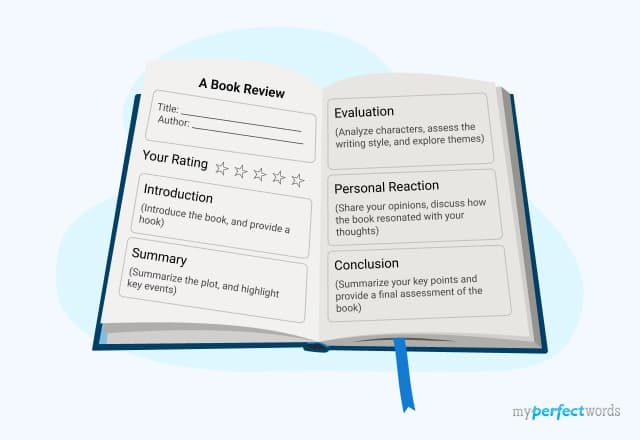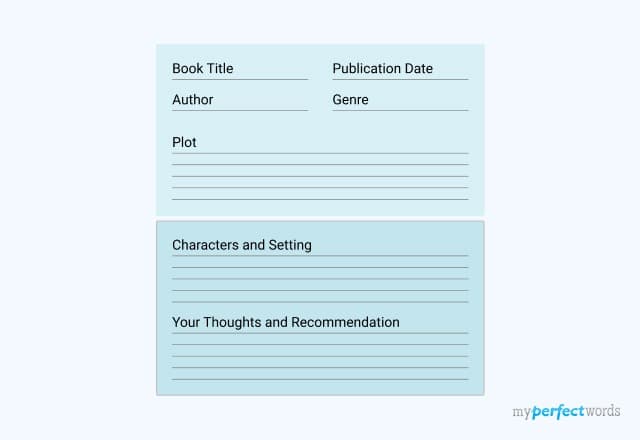Ever stare at a blank page, wondering how to spill your thoughts about a book onto it? You're not alone!
Crafting a compelling book review can be as daunting as facing a dragon in a fantasy novel. The struggle is real. How do you structure your thoughts? And most importantly, how do you make it enjoyable, both for you and your readers?
Fear not, because we've got you covered.
In this guide, we'll take you step by step through the process. We'll share some useful tips and show you real examples. From organizing your review to nailing the writing part, we've got everything covered.
So let's dive in!
On This Page![]()
- 1. What is a Book Review?
- 2. How to Write a Book Review?
- 3. Book Review Format
- 4. Book Review Template
- 5. Book Review Examples
- 6. Book Review Sample Topics
- 7. Tips to Write a Book Review Effectively
What is a Book Review?
A book review is a critical evaluation of a literary work that provides a reader's perspective on its strengths and weaknesses. It goes beyond summarizing the plot, diving into aspects like character development, writing style, and thematic elements.
Through insightful analysis, a book review offers potential readers a nuanced understanding, guiding them in making informed choices. It serves as a valuable tool for both readers and authors, offering constructive feedback for continuous improvement.
How to Write a Book Review?
Let's break down the steps of writing a book review:
Step 1: Read the Book Thoroughly
Read the book attentively, taking note of major plot points, character developments, and any recurring themes. Ensure a clear understanding of the author's narrative choices.
Example:
Step 2: Understand the Author's Intent
Research the author's background, previous works, and writing style. Consider the book's genre and its place in the author's overall body of work to understand their intent.
Example:
Step 3: Identify the Target Audience
Determine the ideal reader for the book. Assess how well the author caters to this audience and whether the content is appropriate for the intended readership.
Example:
Step 4: Compose an Engaging Introduction
Start with a captivating hook, such as an interesting fact or a thought-provoking question. Provide essential information about the book, including the title, author, and genre.
Example:
Step 5: Summarize the Plot Concisely
Provide a brief overview of the plot without revealing spoilers. Focus on the key events that drive the narrative forward.
Example:
Step 6: Evaluate Character Development
Discuss the characters' depth and growth throughout the story. Analyze their relevance to the overall plot and note any notable character traits.
Example:
Step 7: Assess Writing Style and Language
Evaluate the author's writing style and language choices. Comment on how these elements contribute to or hinder the overall reading experience.
Example:
Step 8: Explore Themes and Symbolism
Identify central themes and discuss their significance in the book. Look for symbolism or motifs that enhance the overall meaning of the narrative.
Example:
Step 9: Critique the Ending
Evaluate how well the conclusion wraps up the story. Discuss whether it is satisfying or if it leaves room for interpretation. Avoid giving away crucial plot details.
Example:
Step 10: Share Personal Insights
Express your personal reactions and emotions toward the book. Support your opinions with specific examples or passages from the text that resonated with you.
Example:
Step 11: Maintain Objectivity
Balance criticism with praise. Provide constructive feedback without solely focusing on negative aspects. Base your arguments on evidence from the book.
Example:
Step 12: Consider the Book's Impact
Reflect on the lasting impression the book leaves. Discuss its significance in a broader literary context and consider its potential influence on readers.
Example:
Step 13: Craft a Conclusion
Summarize the key points discussed in your review. Provide a final assessment of the book and recommend it to specific audiences based on its strengths.
Example:
Step 14: Revise and Proofread
Polish your review for clarity and coherence. Check for grammatical errors, and typos, and ensure a professional presentation. Consider seeking feedback from others for additional perspectives.
Book Review Format
In this section, we'll explore how to write a book review format, particularly focusing on the formatting guidelines. Let's explore the essential guidelines that make up a compelling book review:
Title Page:
- Boldly display the book title centered at the top.
- Include the author's name beneath the title.
- Mention the publication date and edition if applicable.
Page Formatting:
- Use standard letter-sized paper (8.5 x 11 inches).
- Set 1-inch margins on all sides for a clean appearance.
Text Formatting:
- Choose a legible font like Times New Roman or Arial.
- Use a 12-point font size for the main text.
- Italicize book titles and maintain consistency in formatting throughout.
Line Spacing:
- Double-space the entire review for readability.
- Single space within paragraphs for a balanced look.
If you want to learn the details of structuring and formatting a book review check out our “book review format” blog!
Book Review Template
Let’s take a look at a sample book review writing template:
Note: The template provided is a general guide, and the structure can vary based on personal preferences or specific requirements.
Book Review Examples
Examples are a great source to learn something new. That’s why below we have provided some book review examples that you can read to understand what it takes to write a great book review.
Fictional Book Review
Here is how to write a book review for a fiction book:
Non-Fiction Book Review
Here is how to write a book review sample for a non-fictional book:
How to Write a Book Review PDF Samples
We have collected a bunch of samples for your how to write a book review example queries. Check out and download to enhance your learning:
Need more examples for better understanding? Check out our book review examples blog for a range of sample book reviews.
Book Review Sample Topics
If you are looking for more book reviews, we have compiled some potential book review topics often designated for student assignments:
- "The Lord of the Rings" by J.R.R. Tolkien
Discuss the epic fantasy, world-building, and themes of friendship and power. - "Pride and Prejudice" by Jane Austen
Explore the societal norms and romantic elements in Austen's beloved novel. - "The Hunger Games" by Suzanne Collins
Analyze the dystopian world, social commentary, and character development in this modern YA classic. - "The Outsiders" by S.E. Hinton
Examine the portrayal of social issues and youth identity in this coming-of-age novel. - "Brave New World" by Aldous Huxley
Discuss the futuristic society, technology, and ethical dilemmas in Huxley's dystopian masterpiece. - "The Color Purple" by Alice Walker
Analyze the narrative of oppression, resilience, and empowerment in Walker's Pulitzer Prize-winning novel. - "The Kite Runner" by Khaled Hosseini
Explore themes of guilt, redemption, and the impact of personal choices in this powerful novel. - "The Book Thief" by Markus Zusak
Reflect on the impact of literature and the resilience of the human spirit during World War II. - "The Picture of Dorian Gray" by Oscar Wilde
Analyze the moral decadence and the consequences of aestheticism in Wilde's classic novel. - "The Joy Luck Club" by Amy Tan
Examine the intergenerational relationships and cultural dynamics in Tan's exploration of Chinese-American experiences.
Tips to Write a Book Review Effectively
Here are some essential tips for writing a top-notch book review:
- Capture Emotions: Express how the book made you feel. Readers connect with genuine emotional responses.
- Highlight Unique Aspects: Bring attention to distinctive elements—be it writing style, character depth, or unusual plot twists.
- Avoid Spoilers: Maintain intrigue by avoiding detailed plot revelations. Let readers discover the story organically.
- Compare Similar Works: Draw comparisons with other books in the same genre to provide context and perspective.
- Proper Content Breakdown: Organize your review into distinct body paragraphs, each focusing on a specific aspect like plot, characters, and themes.
- Consider the Audience: Tailor your review to the likely readership. Evaluate the book's appeal within its target audience.
- Balance Critique: Offer constructive criticism without solely focusing on flaws. Acknowledge the book's strengths and weaknesses. Also, your thesis statement should guide the overarching tone and focus of your critique.
- Connect with Themes: Discuss underlying themes and how they resonate with broader societal or personal contexts.
- Use Vivid Language: Craft your review with descriptive language. Paint a vivid picture without giving away too much.
- Relate to the Author: Explore the author's background, writing influences, or any personal connections that enhance understanding.
- Encourage Discussion: Pose questions or points for discussion to engage readers and stimulate conversation.
Wrapping it Up!
This step-by-step guide has equipped you with the tools to craft a compelling book review. From understanding the book's essence to expressing your personal reactions, we've covered it all.
Remember, a well-crafted review is an art that combines analysis and emotion.
If you find yourself struggling with your book review assignment or seeking professional guidance, don't hesitate to reach out. Our expert writers at MyPerfectWords.com are here to provide the best writing service.
Your academic success is our priority. Reach out to us today, and let us help you with your 'do my essay for me' request!
Frequently Asked Questions
What are the 4 stages of a book review?
The 4 stages of reviewing a book are:
- Introduction the book
- Drafting an outline of its major chapters
- Highlighting the significant details of the book
- Writing a detailed evaluation
What are the parts of a book review?
The main parts of a book review are as following:
- Summary of the book
- Background details of the book
- Credits: author, publisher, etc.
- Plot and setting
- Synthesis
What is the goal of a book review?
The purpose of the book review is to convey information about a particular book in an understandable way. It can be used as a tool by other people who want to know what your review about the book is or how it compares to their own expectations.

Write Essay Within 60 Seconds!
Use our AI tool to generate high quality essay
WRITTEN BY
Cathy A.
Cathy has been been working as an author on our platform for over five years now. She has a Masters degree in mass communication and is well-versed in the art of writing. Cathy is a professional who takes her work seriously and is widely appreciated by clients for her excellent writing skills.




